SR-71 Blackbird Project Senior Crown
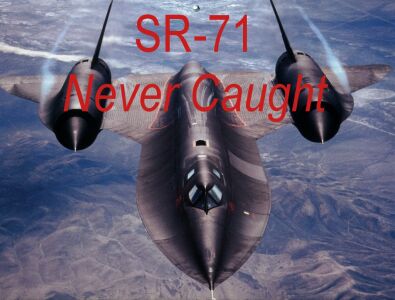
After more than 35 years the Blackbird remains the world's fastest combat aircraft having set numerous world records for speed and altitude including an astonishing Los Angeles to Washington flight time of 1 hr 04 min 19.89 secs at an average speed of 2,144.83 mph. The SR-71 also set records for absolute altitude in sustained horizontal flight: 85,068.997 ft (25,929.031m) and speed over a straight course (15-25 km): 2,193.167 mph. (Mach 3.31)
During its long career of conducting overflights of sensitive areas of the globe no Blackbirds were ever shot down or intercepted, a record that is totally without parallel.
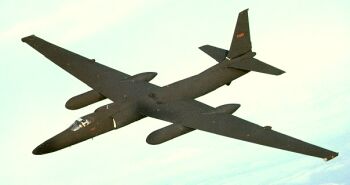
Project Suntan (the CL-400)
The CL-400 was an ambitious liquid-hydrogen powered successor to the U-2 spy plane, it was suppose to fly at speeds of Mach 2.5 at 100,000ft.
Kelly Johnson went to Washington in January of 1956 and convinced the Air Force to tentatively approve the development of two prototype CL-400s which Johnson promised to deliver within 18 months.
In fact the plane never left the drawing board due to enormous technical and design problems. The CL-400 would have to be large enough to carry at least 21,400lb of liquid hydrogen to give it a 2,500 mile range at the planned speed and altitude. The design was reworked again and again but without resolving the range/weight problems. In the summer of 1957 the Air Force was rapidly losing interest in the project and that October Suntan was abandoned.
A-12 'Oxcart'

Between 21 April 1958 and 1 September 1959 the Skunk Works submitted a dozen proposals (labled A-1 through A-12) to Richard Bissell and the Air Force for a successor to the U-2.
Convair (later General Dynamics) 'Kingfisher' Mach 4 launched from the B-58 Hustler.
Navy balloon project
On 29 August 1959 Lockheed's final design, the A-12, was declared the winner
Main Adversary: Mig-25 Foxbat
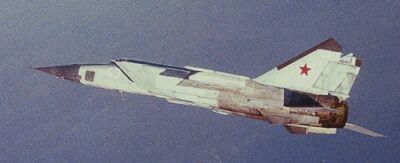
Given the NATO reporting name 'Foxbat', the MiG-25 was designed to intercept the US B-70 bomber that was to have been capable of Mach 3. The B-70 was never built however, so the Soviets were left with a long-range interceptor capable of astonishing speed and a phenomenal rate of climb.
NATO had its first detailed look at the MiG-25 when a Soviet pilot, Lieutenant Viktor Belenko, defected to Japan with one on 6 September 1976. The aircraft landed at Japan's Hakodate Airport where it was closely examined. This exposed its 1950s-era radar, extensive use of steel rather than lighter alloys making the plane very heavy, and other features that dispelled much of the mythology built up by some Western analysts since the first sighting of the 'Foxbat' in 1967.
The Foxbat was powered by two Tumansky R-266 turbojet engines, each developing a maximum thrust of almost 30,000lb. The Foxbat carried an enormous amount of fuel - more than 30,000lb in eight separate tanks. Despite this the plane's endurance at top speed is limited. Additionally, it's maximum speed is Mach 2.83 ( exceeded in a few exceptional cases to Mach 3 which can only be done very briefly.) This is main reason the Mig-25s were unsuccessful in engaging the SR-71 Blackbird.
The Mig-25 was armed with four air-to-air missiles of either infrared heat-seeking and/or radar-guidance types.
KC-135Q Tanker
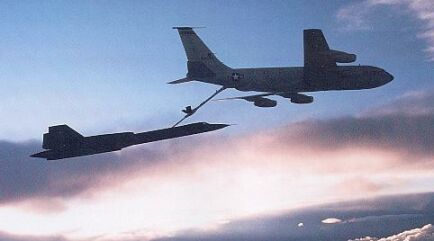
KC-135Q/T
Fifty-six KC-135 tankers were converted to KC-135Qs, which feature additional navigation and communications equipment for the support of the now-retired Lockheed SR-71 fleet. These tankers carried high-flashpoint JP-7 fuel in addition to the standard JP-4/5 used by the tanker itself. They remained capable of refueling other receivers, although the JP-7 tanks had to be purged before they could carry standard fuel. Today the Q-models are often involved in supporting F-117 Nighthawk stealth fighter operations, and are in the process of being re-engined to KC-135T standard.
With the development of the A-12, and then the YF-12A, and SR-71, a special tanker for the unqiue fuel (JP7) used by these aircraft was needed. It has seperate tanks for the fuel used by the SR-71, it was the first aircraft with integral boom intercom (for aircraft to aircraft communication, while still maintaining radio silence), the Q's were also one of the first KC-135's to have the "high speed boom", and a strobes for aircraft safety. 54 aircraft were converted to "Q" specifications.
With the re-engining of the Q's, with F108-CF-100 (CFM-56) engines, their designation has been changed to KC-135T.
Units that flew the KC-135Q:
9th AREFS
70th ARS
100th ARW
306th AREFS
349th ARS
350th ARS
376th SW
380th AREFS
903rd ARS
909th AREFS
KC-135Q Losses
58-0039 on 3 June 1971
60-338 on 2 August 1980
Source: Boeing KC-135 Stratotanker, Modern Combat Aircraft 27, by Robert F. Dorr
D-21A/B Drone
- Construction: Titanium (Beta-120/Ti-13V-11Cr-3A1) Monococque with some super-high-
- temperature palstics
- Length: 42ft, 10 inches
- Wingspan: 19ft, 1/4 inch
- Wing Area: ?
- Height: 7ft, 1/4 inch
- Empty Weight: ?
- Maximum Gross Take-off Weight: 11,000lb
- Maximum Speed: 3.35 Mach/ Maximum 3.25 at 80,000 to 95,000ft
- Operational Ceiling: 95,000ft
- Maximum Unrefueled Range: 3,000 nm
- Armament: None
- Powerplant Data: Marquardt RJ43-MA-11 Ramjet with 1,500lb thrust
D-21 production: 38 drones
D-21A: M-21 launched, 4 launches
D-21B: B-52H launched, 17 Launches, with 4 operational missions
History of TAGBOARD D-21 SENIOR BOWL Project
10 Oct 1962 Skunk Works receives authorization for Drone(Q-12) study from
CIA
Jun 1963 Q-12 drone fit check to A-12 (RK)
1 Oct 1963 Q-12 design finalized, and renamed D-21 (RK)
19 Jun 1964 Fit check of mating of M-21 #134 and D-21 #504 is successful
(LSW)
22 Dec 1964 First flight M-21/D-21 at Groom Lake; Lockheed Test Pilot
Bill Park (piloted all M-21/D-21 flights) (BIA; SME; BB)
5 Mar 1966 First D-21 #503 launched from M-21 #6941, and flew 150 nmi;
Lockheed Test Pilot/FCO: Bill Park/ Keith Beswick (LSW)
27 Apr 1966 Second D-21 #506 launched from M-21 #6941 and flew 1120 nmi;
Lockheed Test Pilot/LCO: Bill Park/ Ray Torrick (LSW)
29 Apr 1966 Second batch of 15 D-21s ordered
16 Jun 1966 Third D-21 #505 launch from M-21 #6941, it flew 1600 nmi;
Lockheed Test Pilot/ LCO: Bill Park/ Keith Beswick (LSW)
30 Jul 1966 Fourth D-21 #504 launch from a M-21 #6941, results in the D-21
colliding with the M-21, both crew eject Pilot Bill Park survives, but LCO Ray
Torrick drowns, ending M-21/D-21 program (AM1; SME)
28 Sep 1967 D-21 #501 accidently dropped from B-52H, while on the ground (LSW)
6 Nov 1967 D-21 #507 launched from B-52H and flew 134 nmi (LSW)
2 Dec 1967 D-21 #509 launched from B-52H and flew 1430 nmi (LSW)
19 Jan 1968 D-21 #508 launched from B-52H and flew 280 nmi (LSW)
30 Mar 1968 D-21 #511 launched from B-52H and flew 150 nmi (LSW)
16 Jun 1968 D-21 #512 launched from B-52H and flew 2850 nmi, camera hatch recovered, but no camera was carried (LSW)
1 Jul 1968 D-21 #514 launched from B-52H and flew 80 nmi (LSW)
28 Aug 1968 D-21 #516 launched from B-52H and flew 78 nmi (LSW)
15 Dec 1968 D-21 #515 launched from B-52H and flew 2953 nmi, camera hatch recovered, photos are "fair" (LSW)
11 Feb 1969 D-21 #518 launched from B-52H and flew 161 nmi (LSW)
10 Jul 1969 D-21 #520 launched from B-52H and flew 2937 nmi, camera pallet recovered, photos good (LSW)
20 Feb 1970 D-21 #521 launched from B-52H and flew 2969 nmi, camera pallet recovered, photos good (LSW)
There are only 4 operational flights:
9 Nov 1969 First operational D-21 mission. D-21 #517 launched from B-52H, no camera pallet recovered (LSW)
16 Dec 1970 Second operational D-21 mission. D-21 #523 launched from B-52H and flew 2448 nmi, no camera pallet recovered (LSW)
4 Mar 1971 Third operational D-21 mission. D-21 #526 launched from B-52H and flew 2935 nmi; camera pallet jettisoned, but not recovered (LSW)
20 Mar 1971 Fourth and last operational D-21 mission. D-21 #527 launched from B-52H and flew 2935 nmi; no camera pallet recovered (LSW)
15 Jul 1971 Lockheed receives word of D-21 program cancellation (LSW)
D-21 Drone #s:
504 503 506 505 501 507 509 508 511 512 514 516 515 518 520 521
Ones which flew operational flights:
517 523 526 527
Operation Blackshield
- Deployment of A-12s/SR-71s to Far East for
overflights. Based at Kadena AB, Okinawa.
Operation Giant Reach
- overflights of the Mid-East during Yom-Yippur
War. A total of 9 nine sorties were flown from Griffis AFB, NY and
Seymour-Johnson AFB, NC.
April 30, 1962. Company pilot Lou Schalk makes the first official flight of the Lockheed A-12, the forerunner of the SR-71 high-speed reconnaissance aircraft, at Groom Lake, Nev. Two earlier "hops" had been made on April 25 and 26.
September 1, 1974. Maj. James V. Sullivan and Maj. Noel Widdifield set a New York-to-London speed record of 1,806.964 mph in a Lockheed SR-71A. The trip takes one hour, fifty-four minutes, fifty-five seconds.
July 27-28, 1976. Three SR-71 pilots (Maj. Adolphus H. Bledsoe, Capt. Robert C. Helt, and Capt. Eldon W. Joersz) set three absolute world flight records over Beale AFB, Calif: altitude in horizontal flight (85,068.997ft), speed over a straight course (2,193.16 mph), and speed over a closed course (2,092.294 mph). The records are still standing in 1996.
SR-71 Blackbird Mach 3 spy plane shape and radar absorbing paint and RAM all helped reduce the RCS of the SR-71
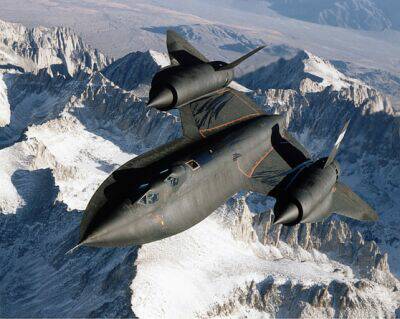
SR-71
SR-71A/B/C
- Construction: Titanium (Beta-120/Ti-13V-11Cr-3A1) Monococque with some
super-high-temperature palstics.
- Length: 107ft, 5 inches
- Wingspan: 55ft, 7 inches
- Wing Area: 1,795 squareft
- Height: 16ft, 6 inches
- Landing Weight: 68,000lb
- Maximum Gross Take-off Weight: 140,000lb
- Maximum Speed: 3.2 Mach above 75,000ft
- Operational Ceiling: over 85,000ft
- Maximum Unrefueled Range: 3,200 nm
- Armament: None
- Powerplant Data: 2 Pratt & Whitney J58 (JT11D-20A)
High-bypass-turbojets with 34,000lb thrust
SR-71 production:
- A...29
- B... 2
- C... 1
- Out of the total of 32 SR-71's built, 21 are still in existance.
- Total SR-71s lost in accidents: 12 (no USAF Pilot or RSO lost their lives
in any SR accident, nor were any shot down by hostile fire)
AF Serial Numbers assigned for the SR-71: 61-17950 through 61-17985
- Serial numbers 61-17982 through 61-17985 were not used
Program Info:(as of Jan 1990)
- Total Flight Hours:...........53,490
- Total Mach 3+ Time:........11,675
- Total Sorties:.....................17,300
- Total Operational Sorties:....3,551
- Total Operational Hours:...11,008
- Total Air Refeulings..........25,862
- Total Crew Members:............284 (includes NASA and USAF Crews checked
out in AC)
- Cumulative Hours by Crews:
- 300 Hours.....163
- 600 Hours.......69
- 900 Hours.......18
- 1000 Hours.......8
- 1392.7 Hours.....1
YF-12A
Length: (excluding nose probe) 101.66ft. Span: 55.62ft
Height: 18.38ft Fuselage ventral fin Area, M2: 6.735 Chords: root 13.7' tip 8.5'
Nacelle ventral fin Area, M2: 2.044 Chords: root 13.93' tip 10.71.
SR-71A
Length: (excluding nose probe) 103.876ft. Length of nose probe: 4'11 1 "
Span: 55.62ft Height: 18'6" Wing area: 1795.00 squareft Aspect ratio: 1.939 Root
chord: 60.533ft Tip chord: 0.00 Dihedral: 0 degrees Sweep: 52.629 degrees
Inboard elevon area: 39.00 squareft Outboard elevon area: 52.50 squareft
Vertical tail total area: 150.76 squareft Movable tall area: 70.24 squareft Root
chord: 14.803ft Tip chord: 7.833ft Fuselage diameter 5.33ft Maximun take-off
weight: 170,000lb (estimated) Empty Weight: 60,000lb (estimated) Equipment: Wide
variety of specialized reconnaissance sensors including, but not limited to,
high resolution cameras, side-looking radar, and IR photography equipment. Recon
bays are configured to accomodate various combinations of recon packages,
depending on particular mission requirements. Max speed: Classified Max
altitude: Classified
| Name: |
SR-71A |
| Manufacture: |
Lockheed 'Skunk
Works' |
| Number Built: |
32 |
| Construction: |
Titanium (Beta-120/Ti-13V-11Cr-3A1) Monococque
with some super-high- temperature palstics. |
| Operating
Speed: |
2,000 mph 3,219
kph (Mach 3+) |
| Max. Speed: |
2,193 mph 3,529
kph (Mach 3.31) |
| Operating
Ceiling: |
85,069 ft ( 25,929 m
) |
| Max. Ceiling: |
101,500 ft ( 30,937 m
) |
| Engines: |
Two Pratt & Whitney
J58 after-burning turbo-ramjets |
| Dry ( Military )
Thrust: |
23,000lb 10,433 kg
(102.3 kN) |
| Wet ( Afterburning )
Thrust: |
32,500lb 14,742 kg
(144.6 kN) |
| Unrefuelled
Range: |
2,982 miles ( 4,800 km
) |
| Length: |
107 ft, 5 in ( 32.74 m
) |
| Height: |
16 ft, 6 in ( ? m
) |
| Wingspan: |
55 ft, 7 in ( 16.94 m
) |
| Wing Area: |
1,795 ft� ( 166.76 m�
) |
| Empty Weight: |
65,000lb ( 29,484 kg
) |
| Max. Fuel
Weight: |
80,000lb ( 36,287 kg
) |
| Normal Takeoff
Weight: |
140,000lb ( 63,503 kg
) |
| Max. Takeoff
Weight: |
170,000lb ( 77,110 kg
) |
| First Operational
Flight: |
March 21,
1968 |
| Total Sorties: |
17,300 |
| Operational
Sorties: |
3,551 |
The 4200th Strategic Reconnaissance Wing ( later renamed the 9th SRW ) was activated on January 1, 1965 at Beale Air Force Base, California. It would be a full year before the base would get it's first SR-71 Blackbird, arriving January 7, 1966. On March 21, 1968 the SR-71 Blackbird flew it's first operational mission, the first of 3,551 over the next 22 years with no losses. Detachments were located at RAF Mildenhall ( Det 4 ) in the United Kingdom providing SR services to NATO, and Det 1 at Kadena AFB, Japan ( Det 1 were phased out in 1989. ) In 1976 all SR-71 operations were moved to the 9th SRW at Beale AFB. Operations continued mainly from Beale until the SR-71's retirement on March 6, 1990. September 1, 1995 saw the reactivation of two SR-71A-model jets and one B-model pilot trainer aircraft as Beale's Detachment 2 at Edwards Air Force Base, Calif. The planes are operated by Air Combat Command.
A-12 Specifications:
- Construction: Titanium (Beta-120/Ti-13V-11Cr-3A1) Monococque with some
super-high-temperature plastics.
- Length: 102ft, 3 inches
- Wingspan: 55ft, 7 inches
- Wing Area: 1,795 square ft
- Height: 18ft, 6 inches
- Landing Weight: 52,000lb
- Maximum Gross Take-off Weight: 117,000lb
- Maximum Speed: 3.2 Mach above 75,000ft
- Operational Ceiling: above 80,000ft
- Maximum Unrefueled Range: Classified
- Armament: none
- Powerplant Data: 2 Pratt & Whitney J75 with 17,000lb thrust on first 5
aircraft during flight testing
- updated to: In production, 2 P & W J58 (JT11D-20A) high-bypass ratio
turbojets with 20,500lb thrust (dry), with afterburner: 31,500lb thrust,
some later engines generated 34,500lb thrust in afterburner.
- A-12 production: 15 aircraft; Only 9 A-12s are still in existance today.
- Serial Numbers assigned to A-12 production was 60-6924 through 60-6948
- Serial numbers 60-6942 through 60-6948 were not used

D-21A/B Drone
- Construction: Titanium (Beta-120/Ti-13V-11Cr-3A1) Monococque with some
super-high- temperature palstics
- Length: 42ft, 10 inches
- Wingspan: 19ft, 1/4 inch
- Wing Area: ?
- Height: 7ft, 1/4 inch
- Empty Weight: ?
- Maximum Gross Take-off Weight: 11,000lb
- Maximum Speed: 3.35 Mach/ Maximum 3.25 at 80,000 to 95,000ft
- Operational Ceiling: 95,000ft
- Maximum Unrefueled Range: 3,000 nm
- Armament: None
- Powerplant Data: Marquardt RJ43-MA-11 Ramjet with 1,500lb thrust
D-21 production: 38 drones
D-21A: M-21 launched, 4 launches
D-21B: B-52 H launched, 17 Launches, with
4 operational missions
April 30, 1962. Company pilot Lou Schalk makes the first official
flight of the Lockheed A-12, the forerunner of the SR-71 high-speed
reconnaissance aircraft, at Groom Lake, Nev. Two earlier "hops" had been made on
April 25 and 26.
September 1, 1974. Maj. James V. Sullivan and Maj. Noel Widdifield set
a New York-to-London speed record of 1,806.964 mph in a Lockheed SR-71A. The
trip takes one hour, fifty-four minutes, fifty-five seconds.
July 27-28, 1976. Three SR-71 pilots (Maj. Adolphus H. Bledsoe, Capt.
Robert C. Helt, and Capt. Eldon W. Joersz) set three absolute world flight
records over Beale AFB, Calif: altitude in horizontal flight (85,068.997ft),
speed over a straight course (2,193.16 mph), and speed over a closed course
(2,092.294 mph). The records are still standing in 1996.
SR-71 Blackbird Mach 3 spy plane shape and radar absorbing paint and RAM all
helped reduce the RCS of the SR-71

SR-71
SR-71A/B/C
- Construction: Titanium (Beta-120/Ti-13V-11Cr-3A1) Monococque with some
super-high- temperature palstics.
- Length: 107ft, 5 inches
- Wingspan: 55ft, 7 inches
- Wing Area: 1,795 square ft
- Height: 16ft, 6 inches
- Landing Weight: 68,000lb
- Maximum Gross Take-off Weight: 140,000lb
- Maximum Speed: 3.2 Mach above 75,000ft
- Operational Ceiling: over 85,000ft
- Maximum Unrefueled Range: 3,200 nm
- Armament: None
- Powerplant Data: 2 Pratt & Whitney J58 (JT11D-20A)
High-bypass-turbojets with 34,000 lb thrust
SR-71 production:
- A...29
- B... 2
- C... 1
- Out of the total of 32 SR-71's built, 21 are still in existance.
- Total SR-71s lost in accidents: 12 (no USAF Pilot or RSO lost their lives
in any SR accident, nor were any shot down by hostile fire)
AF Serial Numbers assigned for the SR-71: 61-17950 through 61-17985
- Serial numbers 61-17982 through 61-17985 were not used
Program Info:(as of Jan 1990)
- Total Flight Hours:...........53,490
- Total Mach 3+ Time:........11,675
- Total Sorties:.....................17,300
- Total Operational Sorties:....3,551
- Total Operational Hours:...11,008
- Total Air Refeulings..........25,862
- Total Crew Members:............284 (includes NASA and USAF Crews checked
out in AC)
- Cumulative Hours by Crews:
- 300 Hours.....163
- 600 Hours.......69
- 900 Hours.......18
- 1000 Hours.......8
- 1392.7 Hours.....1
| Name: |
SR-71A |
| Manufacture: |
Lockheed 'Skunk
Works' |
| Number Built: |
32 |
| Construction: |
Titanium (Beta-120/Ti-13V-11Cr-3A1) Monococque
with some super-high- temperature palstics. |
| Operating
Speed: |
2,000 mph 3,219
kph ( Mach 3+ ) |
| Max. Speed: |
2,193 mph 3,529
kph ( Mach 3.31 ) |
| Operating
Ceiling: |
85,069 ft ( 25,929 m
) |
| Max. Ceiling: |
101,500 ft ( 30,937 m
) |
| Engines: |
Two Pratt & Whitney
J58 after-burning turbo-ramjets |
| Dry ( Military )
Thrust: |
23,000lb 10,433 kg
( 102.3 kN ) |
| Wet ( Afterburning )
Thrust: |
32,500lb 14,742 kg
( 144.6 kN ) |
| Unrefuelled
Range: |
2,982 miles ( 4,800 km
) |
| Length: |
107 ft, 5 in ( 32.74 m
) |
| Height: |
16 ft, 6 in ( ? m
) |
| Wingspan: |
55 ft, 7 in ( 16.94 m
) |
| Wing Area: |
1,795 ft� ( 166.76 m�
) |
| Empty Weight: |
65,000lb ( 29,484 kg
) |
| Max. Fuel
Weight: |
80,000lb ( 36,287 kg
) |
| Normal Takeoff
Weight: |
140,000lb ( 63,503 kg
) |
| Max. Takeoff
Weight: |
170,000lb ( 77,110 kg
) |
| First Operational
Flight: |
March 21,
1968 |
| Total Sorties: |
17,300 |
| Operational
Sorties: |
3,551 |
The 4200th Strategic Reconnaissance Wing ( later renamed the 9th SRW ) was activated on January 1, 1965 at Beale Air Force Base, California. It would be a full year before the base would get it's first SR-71 Blackbird, arriving January 7, 1966. On March 21, 1968 the SR-71 Blackbird flew it's first operational mission, the first of 3,551 over the next 22 years with no losses. Detachments were located at RAF Mildenhall ( Det 4 ) in the United Kingdom providing SR services to NATO, and Det 1 at Kadena AFB, Japan ( Det 1 were phased out in 1989. ) In 1976 all SR-71 operations were moved to the 9th SRW at Beale AFB. Operations continued mainly from Beale until the SR-71's retirement on March 6, 1990. September 1, 1995 saw the reactivation of two SR-71A-model jets and one B-model pilot trainer aircraft as Beale's Detachment 2 at Edwards Air Force Base, Calif. The planes are operated by Air Combat Command.
Aurora
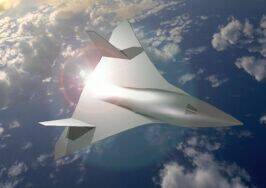
Aurora and Senior Citizen are names for a super-secret Mach 6 - 8 spy plane of advanced design that is speculated to fly out of Area 51 in Nevada. The evidence for the existence of this project is considerable including government documents, numerous sightings and seismic data. However it seems likely that this project is experimental and no longer intended to produce a manned aircraft to enter service with the military.







